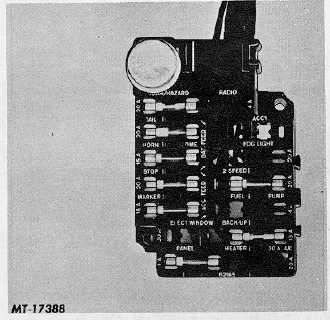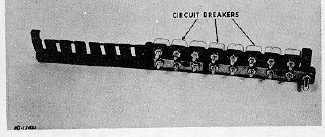|
| |
TRUCK SERVICE MANUAL
TM 5-4210-230-14&P-1
ELECTRICAL
DESCRIPTION
All chassis incorporate safety devices to protect
electrical wiring and equipment from short circuits or electrical
overloads. These protective devices may be fuses, circuit
breakers or fusible links.
Fuses
Fuses are designed to pass a given amount of current.
The current flow limit is indicated by the rating or "Size" of the
fuse (10 ampere, 14 ampere, etc.). Exceeding this limit will
cause the fuse to "blow" opening the circuit.
After the cause of the overload is determined and
corrected, a new fuse must be installed in the circuit. Do not
replace a "blown" fuse with a fuse of higher capacity. To do
so may result in damage to electrical components or wiring.
Where fuse failure is encountered, correct the cause of the
overload and install a new fuse of the originally specified
rating.
Fuses for most vehicle wiring circuits are grouped
together in a fuse panel (Figure 1). Some fuse panels have
removable fuse terminals which can be replaced if
Figure 1 Fuse Panel (Typical)
damaged. Most fuse panels provide space to install
additional fuse terminals if needed for installation of
accessory circuits.
Locations of fuse panels on various vehicle models are
shown in this section.
Circuit Breakers
Circuit breakers are designed to open the circuit any
time current demand exceeds the capacity of the breaker. In
the event of short or overload, the circuit breaker will open due
to excessive heat developed by the higher amperage passing
through it. When the heat dissipates, the breaker will close
allowing current flow again.
If the cause of the short or overload has not been
removed, the circuit breaker will open again to protect the
circuit. The current flow limit is indicated by the rating
(capacity) of the circuit breaker--15 amperes, 20 amperes,
etc. Do not replace a circuit breaker with one of a higher
capacity.
Circuit breakers for vehicle wiring circuits are generally
grouped together in a circuit breaker panel. Most circuit
breaker panels provide space for installing additional circuit
breakers if needed for installation of accessory circuits.
Figure 2 Circuit Breaker Panel (Typical)
Figure 2 illustrates the type of circuit breakers used in
heavy duty vehicles equipped with circuit breaker panels.
Figure 3 shows another type of
CTS-2672Q Page 3
PRINTED IN UNITED STATES OF AMERICA
|


